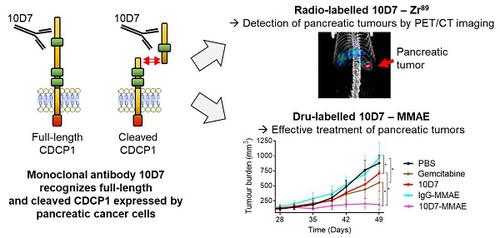Theranostics ( IF 12.4 ) Pub Date : 2020-01-01 , DOI: 10.7150/thno.43589 Thomas Kryza 1 , Tashbib Khan 1 , Simon Puttick 2 , Chao Li 3 , Kamil A Sokolowski 4 , Brian Wc Tse 4 , Tahleesa Cuda 1 , Nicholas Lyons 1 , Madeline Gough 1, 5 , Julia Yin 6, 7 , Ashleigh Parkin 6, 7 , Elena I Deryugina 8 , James P Quigley 8 , Ruby H P Law 9 , James C Whisstock 9 , Andrew D Riddell 10, 11 , Andrew P Barbour 12, 13 , David K Wyld 10, 14 , Paul A Thomas 10, 14, 15 , Stephen Rose 2 , Cameron E Snell 1, 5 , Marina Pajic 6, 7 , Yaowu He 1 , John D Hooper 1

|
Background: CUB domain-containing protein 1 (CDCP1) is a cell surface receptor regulating key signalling pathways in malignant cells. CDCP1 has been proposed as a molecular target to abrogate oncogenic signalling pathways and specifically deliver anti-cancer agents to tumors. However, the development of CDCP1-targeting agents has been questioned by its frequent proteolytic processing which was thought to result in shedding of the CDCP1 extracellular domain limiting its targetability. In this study, we investigated the relevance of targeting CDCP1 in the context of pancreatic ductal adenocarcinoma (PDAC) and assess the impact of CDCP1 proteolysis on the effectiveness of CDCP1 targeting agents.
Methods: The involvement of CDCP1 in PDAC progression was assessed by association analysis in several PDAC cohorts and the proteolytic processing of CDCP1 was evaluated in PDAC cell lines and patient-derived cells. The consequences of CDCP1 proteolysis on its targetability in PDAC cells was assessed using immunoprecipitation, immunostaining and biochemical assays. The involvement of CDCP1 in PDAC progression was examined by loss-of-function in vitro and in vivo experiments employing PDAC cells expressing intact or cleaved CDCP1. Finally, we generated antibody-based imaging and therapeutic agents targeting CDCP1 to demonstrate the feasibility of targeting this receptor for detection and treatment of PDAC tumors.
Results: High CDCP1 expression in PDAC is significantly associated with poorer patient survival. In PDAC cells proteolysis of CDCP1 does not always result in the shedding of CDCP1-extracellular domain which can interact with membrane-bound CDCP1 allowing signal transduction between the different CDCP1-fragments. Targeting CDCP1 impairs PDAC cell functions and PDAC tumor growth independently of CDCP1 cleavage status. A CDCP1-targeting antibody is highly effective at delivering imaging radionuclides and cytotoxins to PDAC cells allowing specific detection of tumors by PET/CT imaging and superior anti-tumor effects compared to gemcitabine in in vivo models.
Conclusion: Independent of its cleavage status, CDCP1 exerts oncogenic functions in PDAC and has significant potential to be targeted for improved radiological staging and treatment of this cancer. Its elevated expression by most PDAC tumors and lack of expression by normal pancreas and other major organs, suggest that targeting CDCP1 could benefit a significant proportion of PDAC patients. These data support the further development of CDCP1-targeting agents as personalizable tools for effective imaging and treatment of PDAC.
中文翻译:

有效靶向完整和蛋白水解的CDCP1,用于胰腺导管腺癌的成像和治疗。
背景:含CUB结构域的蛋白1(CDCP1)是调节恶性细胞中关键信号通路的细胞表面受体。已经提议将CDCP1作为消除致癌信号通路的分子靶标,并将抗癌剂特异性地递送至肿瘤。然而,CDCP1靶向剂的开发受到其频繁的蛋白水解加工的质疑,据认为其导致CDCP1胞外域的脱落限制了其靶向性。在这项研究中,我们调查了靶向CDCP1在胰腺导管腺癌(PDAC)中的相关性,并评估了CDCP1蛋白水解对CDCP1靶向剂有效性的影响。
方法:在多个PDAC队列中通过关联分析评估CDCP1与PDAC进展的关系,并评估PDAC细胞系和患者来源细胞中CDCP1的蛋白水解过程。使用免疫沉淀,免疫染色和生化分析评估了CDCP1蛋白水解对其在PDAC细胞中可靶向性的影响。通过使用表达完整或切割的CDCP1的PDAC细胞的体外和体内实验,通过功能丧失来检查CDCP1在PDAC进展中的参与。最后,我们生成了针对CDCP1的基于抗体的成像和治疗剂,以证明靶向该受体用于检测和治疗PDAC肿瘤的可行性。
结果:PDAC中CDCP1的高表达与较差的患者生存率显着相关。在PDAC细胞中,CDCP1的蛋白水解作用并不总是导致CDCP1胞外域的脱落,它可以与膜结合的CDCP1相互作用,从而允许不同CDCP1片段之间的信号转导。靶向CDCP1会独立于CDCP1切割状态而损害PDAC细胞功能和PDAC肿瘤生长。靶向CDCP1的抗体在向PDAC细胞传递成像放射性核素和细胞毒素方面非常有效,与体内模型中的吉西他滨相比,可以通过PET / CT成像特异性检测肿瘤,并具有出色的抗肿瘤作用。
结论:CDCP1不依赖其裂解状态,在PDAC中发挥致癌作用,并且具有潜在的靶向作用,可用于改善该癌症的放射学分期和治疗。它在大多数PDAC肿瘤中的表达升高,而在正常胰腺和其他主要器官中却缺乏表达,这表明靶向CDCP1可以使相当大比例的PDAC患者受益。这些数据支持CDCP1靶向剂作为可个性化的工具进行有效的PDAC成像和治疗的进一步开发。


















































 京公网安备 11010802027423号
京公网安备 11010802027423号